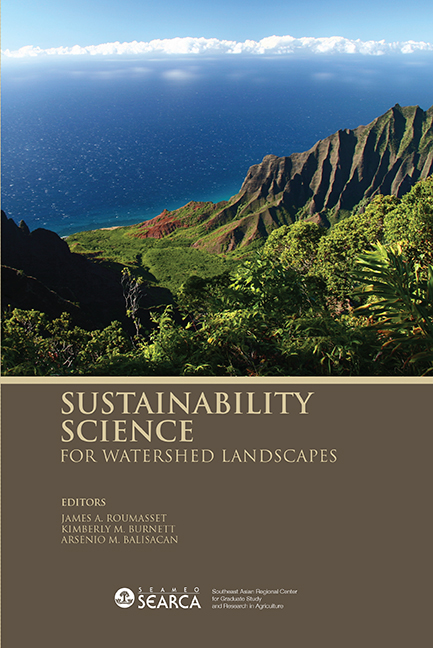Book contents
- Frontmatter
- Contents
- Tables
- Figures
- Message
- Foreword
- Preface
- Acknowledgments
- List of Contributors
- Theme 1 Sustainability Science for Resource Management and Policy
- 1 Economic Policy for Sustainable Development vs. Greedy Growth and Preservationism
- 2 Integrated Watershed Management: Trees, Aquifers, Reefs, and Mud
- 3 Transdisciplinary Research in Watershed Conservation: Experiences, Lessons, and Future Directions
- 4 Payments for Ecological Services: Experiences in Carbon and Water Payments in the Philippines
- Theme 2 Monitoring and Modelling
- Theme 3 Participatory Approaches
- Theme 4 Case Studies
- Synthesis
1 - Economic Policy for Sustainable Development vs. Greedy Growth and Preservationism
from Theme 1 - Sustainability Science for Resource Management and Policy
Published online by Cambridge University Press: 21 October 2015
- Frontmatter
- Contents
- Tables
- Figures
- Message
- Foreword
- Preface
- Acknowledgments
- List of Contributors
- Theme 1 Sustainability Science for Resource Management and Policy
- 1 Economic Policy for Sustainable Development vs. Greedy Growth and Preservationism
- 2 Integrated Watershed Management: Trees, Aquifers, Reefs, and Mud
- 3 Transdisciplinary Research in Watershed Conservation: Experiences, Lessons, and Future Directions
- 4 Payments for Ecological Services: Experiences in Carbon and Water Payments in the Philippines
- Theme 2 Monitoring and Modelling
- Theme 3 Participatory Approaches
- Theme 4 Case Studies
- Synthesis
Summary
ABSTRACT
Sustainability science emerged from the felt need to employ appropriate science and technology in the pursuit of sustainable development. The existing sustainability science agenda emphasises the importance of using a systems approach, stressing the many interactions between natural and human systems. Despite its inertia and avowed purpose of being practical and feasible, however, sustainability science has yet to embrace the policy sciences. In pursuit of this objective, we first trace the history of thought of sustainable development, including its definition and operationalisation.
Sustainable development encompasses sustainable growth and dynamically efficient development patterns. Two promising approaches to sustainable growth are contrasted. Negative sustainability counsels policy makers to offset any decrease in natural capital with at least the same value of net investment in produced capital. This sustainability criterion cannot determine how and how much to conserve natural capital nor how much to build up human and productive capital. Indeed, there is ambiguity regarding what prices to use in summing the values of diverse capital assets. To fill the void, we offer positive sustainability, which maximises intertemporal welfare while incorporating system linkages, dynamic efficiency, and intertemporal equity. This provides a solid and operational framework for sustainable growth. In addition, sustainable development must include the lessons from development theory, including how optimal patterns of production, consumption, and trade change with standards of living.
However, like Tolstoy's unhappy families, there are many pathways to unsustainable development. We describe two broad causes of unsustainable growth – rent-seeking and preservationism. We also illustrate patterns of unsustainable development by drawing on lessons from the Philippines. While specialisation is the engine of growth, fragmentation is the anchor. In addition to natural fragmentation from natural trade barriers in an island archipelago, rent-seeking promotes economic stagnation. Low economic growth in turn exacerbates population pressure and environmental degradation – the vicious circle of unsustainable development.
- Type
- Chapter
- Information
- Sustainability Science for Watershed Landscapes , pp. 3 - 46Publisher: ISEAS–Yusof Ishak InstitutePrint publication year: 2010

